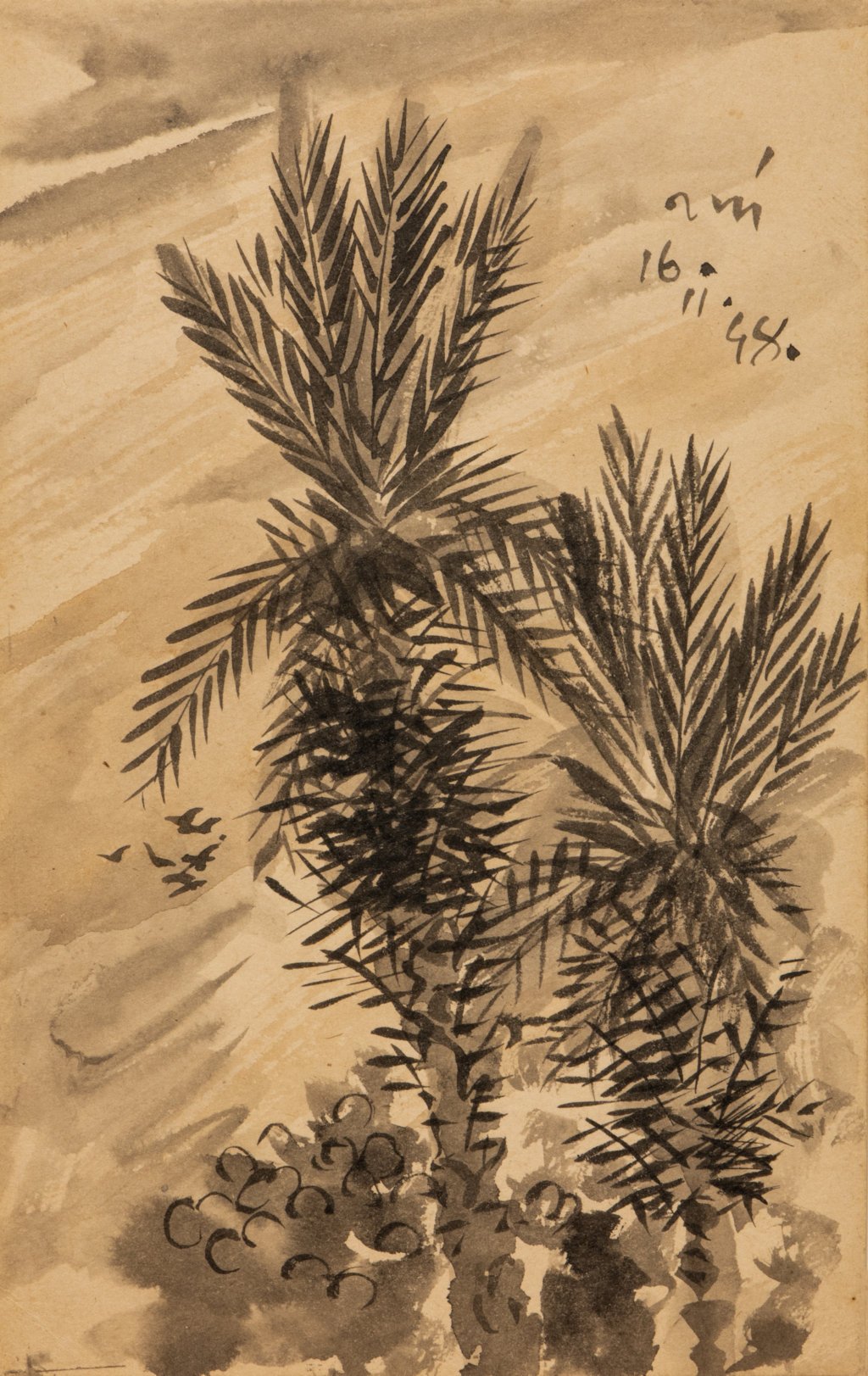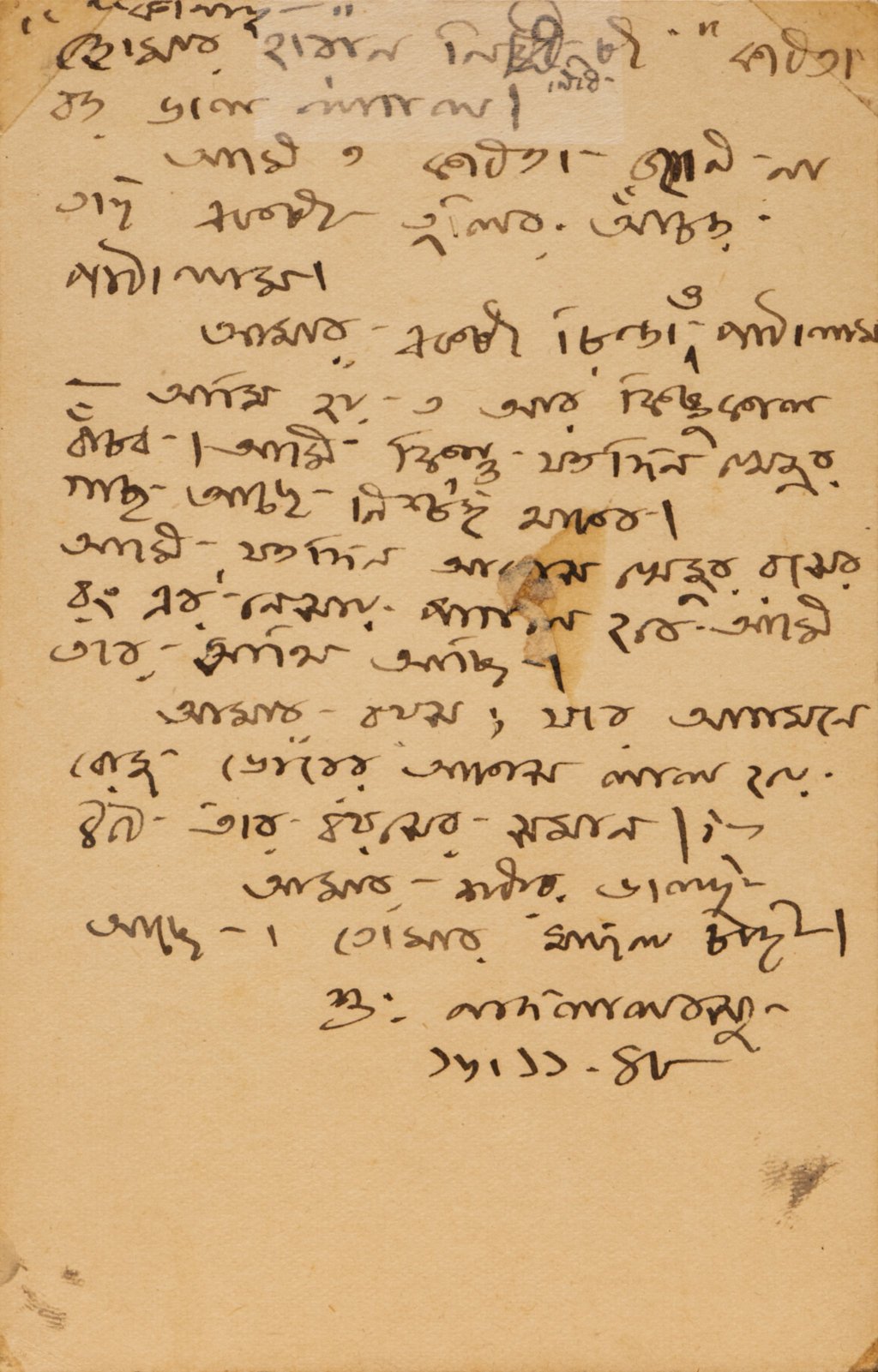
Mastermoshai Nandalal Bose
January 31 - February 29, 2024 at Akar Prakar, Delhi
Nandalal Bose was perpetually drawing on cards and postcards.
However, the pursuit of this activity was not just limited to him. He had instilled, both in his students as well as fellow professors, this practice of postcard drawing. Thus everyone, teachers and students alike, would remain engrossed in this vocation.
Most of Nandalal's cards are executed in monochrome - free from the bindings of colour. This approach set him apart from his Guru, Abanindranath Tagore. According to Abanindranth Tagore, lines are the containers within which colours are held. He was of the view that it was primarily through colour that a painting could be brought to life. Nandalal, on the other hand, was extremely inquisitive about the many possibilities of lines. He found validation for his search in his encounter with Arai Kampo - leading him further towards his journey of monochromatic works.
It was his travels to East Asia that eventually paved the way for his huge body of work in brush and ink and strengthened his belief that black and white contain within them the potentialities of all the other colours. The printmaking techniques which became integral to the pedagogic practices of Kala Bhavana were also a result of Nandalal's travels to China and Japan. He had brought back with him various ukiyo-e prints and wood blocks.
While Indian classical art was highly encouraging of the use of a polychromatic colour scheme, the empowered use of monochrome brought with Nandalal the ‘Asian mode’ of understanding as a pedagogical practice to Santiniketan. Among the two schools of landscape painting - the Western traditions shaped by the likes of Constable and Turner and that of the Chinese Landscape tradition - he was drawn towards the latter’s approach to nature and landscape painting. This further underscores his inclination towards an Asian belief system. When speaking of Nandalal's inspirations from Japan, his strong affirmation of the local and the current surroundings comes to light. This becomes an integral part of his cards.
In this current exhibition, we attempt to highlight how cards/postcards bring out tangents of Nandalal Bose that have remained unnoticed otherwise. This exhibition attempts to bring to light Nandalal’s departure from the earlier influence of Abanindranath Tagore to the influences that Ramakrishna, Rabindranath and Gandhi had on his art practice. It will also highlight Nandalal’s search for spirituality within nature and the establishment of the Asian aesthetic mode. The exhibition will thus showcase how all these tangents are present throughout his works and some of the best can be found in his cards and postcards.
- Curated by Debdutta Gupta
Lady inside a tent | Paper Collage on Cardboard | 5 x 7 inches | 1950s
Gaelo Gaelo Gaelo (stealing the hen) | Paper collage & drawing on cardboard | 4 x 6 in | 1954
Bird | Paper Collage & Drawing on Cardboardboard | 5 x 7 in | 1954
Bird with Butterfly | Paper Collage & Drawing on Cardboardboard | 4 x 6 in | circa 1950
Untitled | Pen & Ink on Postcard | 5.25 x 3.25 in | 1943
Untitled | Collage | 4 x 3 in | 1954
Untitled | Collage | 4 x 3 in | 1954
Bapu ji | Print | 11.25 x 6.25 in | 1930
Untitled (Front) | Pen & Ink on Paper | 3.5 x 5.5 in | 1954
Untitled | Watercolor on Paper | 3.5 x 2.75 in | 1953
Bapuji | Linocut Print on Paper | 12 x 7.25 in | 1930
Untitled | Ink & Brush on Postcard | 3.5 x 5.5 in
Dhutura Flower| Ink & Brush | 5.5 x 3.5 in | 1953
Alpana | Ink & Brush on Postcard | 5.5 x 3.5 in, 3.5 x 5.5 in
Old Calcutta | Ink & Brush | 5.25 x 3.5 in
Untitled | Pen & Ink on Postcard | 3.5 x 5.25 in | 1955
Untitled | Watercolour on handmade paper pasted on paper | 9.25 x 10 in | 1955
Untitled | Print | 12.75 x 4.75 in
Untitled (Front) | Pen & Ink on Postcard | 3.5 x 5.5 in | 1950
Untitled | Watercolor on Paper | 5.5 x 3.5 in
Untitled (Front) | Ink & Brush on Postcard | 5.25 x 3.25 in
Untitled (Back) | Ink & Brush on Postcard | 5.25 x 3.25 in
Untitled (Front) | Ink & Brush on Paper | 5.25 x 3.5 in | 1948
Untitled (Back) | Ink & Brush on Paper | 5.25 x 3.5 in | 1948
Untitled (Front) | Ink & Brush on Postcard | 3.25 x 5.25 in
Untitled (Back) | Ink & Brush on Postcard | 3.25 x 5.25 in
Untitled (Front) | Watercolor on Paper | 5.5 x 3.5 in
Untitled (Back) | Watercolor on Paper | 5.5 x 3.5 in
Untitled | Ink & Brush on Paper | 6.5 x 9.75 in
Untitled | Watercolor on Paper | 5.5 x 3.25 in
Nandalal Bose (1882- 1966)
Born in 1882, Nandalal Bose was one of the pioneers of modern Indian art and a key figure of Contextual Modernism. A pupil of Abanindranath Tagore, Nandalal Bose was known for his ‘Indian style’ of painting. He became the principal of Kala Bhavan, Santiniketan in 1922. He was influenced by the Tagore family, E B Havell, A K Coomaraswamy, and Mahatma Gandhi. Bose achieved fame not only for his renderings of plays by Rabindranath Tagore but also for his designing and execution of the venues of the Indian National Congress conventions in Lucknow, Faizpur, and Haripura from 1935 to 1938. He was the only artist that Gandhi ever patronized. While he had already been internationally recognized as an important artist, his association with Gandhi elevated him to the status of a national icon. In the year 1954, he was honored with the Padma Vibhushan award.
Akar Prakar has exhibited his works in numerous exhibitions since 2011 including Postcards by Nandalal Bose at Akar Prakar, Kolkata (2011), Nandalal Bose & Benode Behari Mukherjee at Lalit Kala Akademi, New Delhi (2012), Nandalal Bose at Akar Prakar, Kolkata (2023) and Mastermoshai Nandalal Bose at Akar Prakar, New Delhi (2024).


































